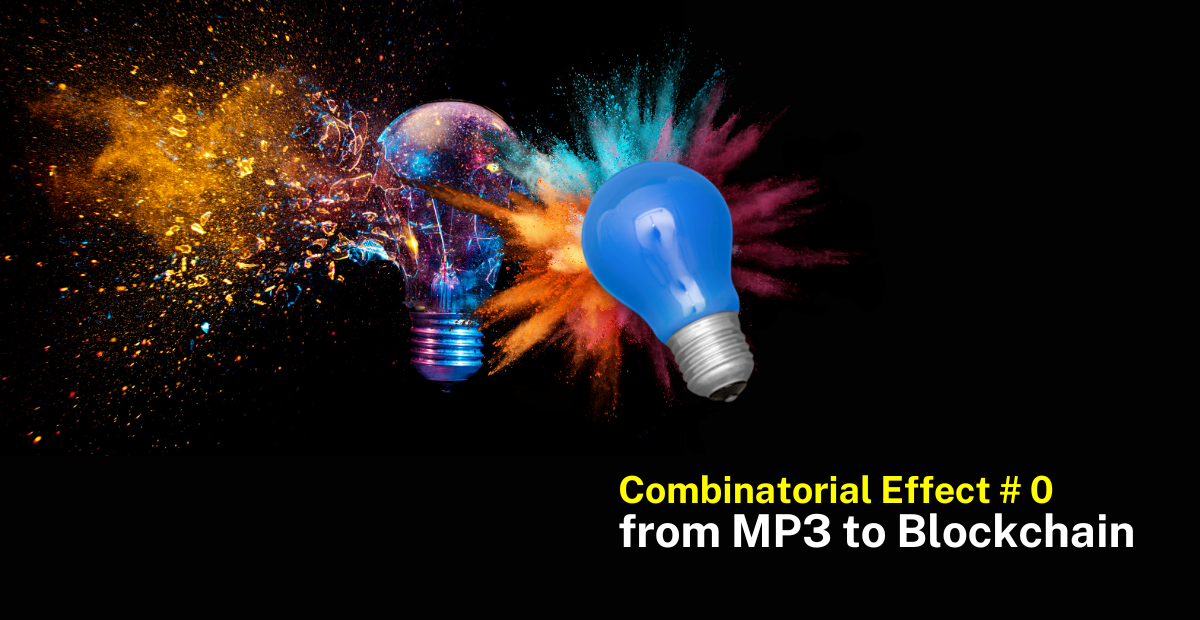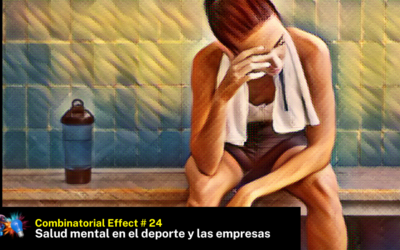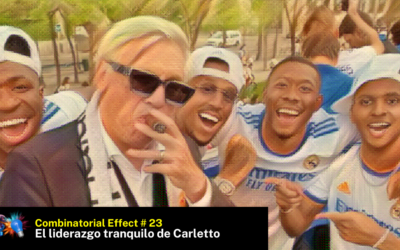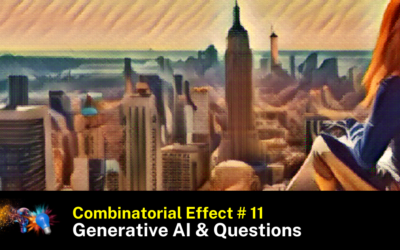Combinatorial Effect # 0: from MP3 to Blockchain
Combinatorial Effect is a newsletter with stories of people who have helped build amazing businesses powered by technology. Get inspired to build projects, improve your problem-solving mindset and conquer the world by creating solutions.
Keep connecting the dots to ignite our innovative spirit.
________________________________________________________________________
Combinatorial effect # 0 Premiére issue
This is our opera prima.
In this issue, we are going to connect some dots through the stories of people who have led initiatives that transformed the music industry.
Let´s see this example of the Combinatorial effect.
How do you connect the following dots? 👇 All of them have impacted the music industry’s evolution
🌎 mp3 ←→ Napster ←→ iTunes ←→ Blockchain 🌎 Suzanne Vega ← → Sean Parker ←→ Steve Jobs ←→ Vitalik Butterin
By making this type of connection, we can discover insightful lessons behind the stories of people who have led technology growth.
Everybody can build their ways to connect these points, and the most important thing is the process itself, which helps us to strengthen our problem-solving mindset.
The Father and the Mother of MP3
Every creation has its parents, the people who contributed to making the creature alive. Or in some cases, people who are perfectly located are remembered in the history of this creation.
Regarding MP3, let´s check two persons who typically are considered its parents.
Karlheinz Brandenburg, Internet Hall of fame inductee, 2014
He is a german electric engineer and mathematician, who worked together with some colleagues on creating a method to compress audio data (aka mp3)
I mentioned him on behalf of the team of colleagues: Ernst Eberlein, Heinz Gerhäuser (former Institutes Director of Fraunhofer IIS), Bernhard Grill, Jürgen Herre, and Harald Popp
Brandenburg won many prizes during his career and was inducted into the Internet Hall of fame in 2014, for his contributions to technology.
Let’s say in the 80s he was working to develop feasible methods to compress audio data in their laboratory in Germany 🇩🇪
A vital decision to keep moving forward with the technology was selecting the right track to use, which guaranteed the new methods developed to compress all the audio properly.
And this is the moment when the mp3’s mother appeared. Why?
Let me tell you…
How did the mother appear in the scene?
Suzanne Vega is a popular singer and songwriter, known in the ’80s and ’90s most for 2 hits called ¨Luka¨ and ¨Tom’s dinner¨
Beyond getting these 2 súper hits, her vocal performances and compositions are incredible and provide a warm taste to love. That´s the reason why my favorite versions are acapella ones.
You may remember the initial sounds of Tom´s dinner song…
“ Doo, doo, doo, doo, doo, doodoo, doo Doo, doo, doo, doo, doo, duhdoodoo Doo, doo, doo, doo, doo, doodoo, doo Doo, doo, doo, doo, doo, duhdoodoo “
“ I am sitting in the morning at the diner on the corner I am waiting at the counter for the man to pour the coffee And he fills it only halfway, and before I even argue
He is looking out the window at somebody coming in”
You can find the complete lyrics here → → https://www.billboard.com/music/lyrics/annenmaykantereit-giant-rooks-toms-diner-lyrics-1235058702/
This acapella version lyric captivated Brandenburg, who thought it was the perfect one to test versions of the upcoming compression technology, as it raises the bar in the process of finding methods to preserve the quality of the song while reducing the file size.
He was right, and the first compressions were awful, turning this perfect performance into a vocal nightmare.
Development continued until the team found the best algorithm to reduce the size of the audio files with the best possible quality, with a special focus on preserving the warmth of the voice.
To make the story short, this method was named MP3 which means MPEG audio Layer-3.
Find more information about the origin of the name in this article, written by The Times of India, Dec 9, 2006: https://timesofindia.indiatimes.com/why-is-an-mp3-file-called-so/articleshow/756079.cms
The MP3 standard was developed at the Fraunhofer Institute for Integrated Circuits IIS, which is the organization that has the right to license the mp3 format.
It was an extended process that began in the 1970s and has been worth more than 100 million dollars in income for the licensing of the MP3 technology.
I recommend you to have a look at the Fraunhofer website, which consolidates all the information related to the standard: history, the team behind the achievement, marketing, technology, and timeline: The mp3 History
Information for Geeks 👇
Optimum Coding in the Frequency (OCF) algorithm which is the original name of the MP3 format, was presented in 1987 at the IEEE forum by Mr. Bradenburg in the paper you can find in the following link: OCF–A new coding algorithm for high-quality sound signals
And please, see the timeline on the official Fraunhofer website, to check the details of the MP3´s History: Timeline
Facts for music lovers 👇 🎵
For starting, let me invite you to see this interview from the Great Big Story YT channel, in which Brandenburg talks about the mp3 creation process.
How a Suzanne Vega Song Helped Create the MP3
And now, let me share some links about Suzanne Vega and her song:
Suzanne Vega is the “Mother of the MP3”
These are 2 versions of the original acapella song used by german scientists to test their mp3 technology: Suzanne Vega – Tom’s Diner (Acapella Version)
Suzanne Vega – Tom’s Diner (Live At Royal Albert Hall/1986)
and, this is the official video of the song:
Suzanne Vega, DNA – Tom’s Diner (Official Music Video)
And finally, a question for the ones who love New York 👇
Do you recognize this restaurant?
Indeed, this is the one that inspired Suzanne Vega´s song, and as you may notice, the exterior of the restaurant was the place where Seinfeld and his friends convened to dine.
It´s located at 2880 Broadway (on the corner of West 12th Street), Morningside Heights in Manhattan, New York.

Image of the exterior of Tom´s restaurant in New York.
Credits_. By Danny-w – Own work, CC BY-SA 3.0, https://commons.wikimedia.org/w/index.php?curid=20384577
Coming back to MP3 and music…
🤔 How many songs have been shared since the mp3 format was born? I think millions or billions.
Beyond the exact number, it is key to see how much the music industry has changed since this German team developed the new format.
Check out this HubSpot article on the subject:
From the Phonograph to Spotify: The History of Streaming Music
And now, let´s connect another dot, by seeing what happened after the mp3 standard was released…
An underground technology for sharing music in the late 90s
June 1, 1999
A new music file-sharing service has been launched, and in a short time has become mainstream among people using computers today.
The main people behind this service are Shawn Fanning (creator), and Sean Parker (co-founder).
Yes, the same Sean Parket who years later would play a role in the growth of a new social network.
Beyond the conquest of mass audiences, Napster captured the attention of the entire music industry, which initially saw the service as a serious problem.
This initial assault between traditional music distribution and Napster ended with the closure of the services in 2001. But MP3 was more alive than ever, buoyed by the results of a massive experiment in music sharing.
Napster | Definition, History, & Facts
Napster’s most important legacy was uncovering the value of a new global distribution model that transformed the music industry forever.
Why if we sell tracks instead of complete albums?
“1,000 songs in your pocket”
That was the way Steve Jobs use to present the iPod, a device that transformed mobility and storage
The Internet evolved and became a faster way to transmit data, and it allowed
Steve Jobs and iTunes → → creating ecosystems to build global communities and serve global audiences

“1,000 Songs In Your Pocket” – Influence Digital
Radiohead, one of the firsts artist to sell their music by tracks:
Remix Radiohead’s “Reckoner” on iTunes | Engadget
And nowadays, the blockchain is transforming music again
To make a long story short, I want to say that blockchain has profoundly impacted music by changing ownership.
Today, you can buy all the rights to creation by acquiring an NFT.
It’s huge and it’s just getting started 🚀
So we’ll come back to it in future reviews.
For now, let’s look at how music buying has evolved over the last 4 decades with technology:
buy albums → buy songs → buy rights
Rights ownership is a new case of use that is still under development. We will be seeing its evolution in the following 5 to 10 years.
15 Companies Utilizing Blockchain in Music to Reshape a Changing Industry

Combinatorial effects takeaways
Can you see it?
When humans connect the dots, amazing things happen.
I want to highlight three points:
- Innovation happens when we connect the dots in a different way (like music and technology in the 1980s) and is the result of several experiments.
- Time is key, and in some cases, we can see it in the underground technologies that have been adopted before: in this issue, we do not mention electricity, computing devices, and the internet, but they were all there and played a key role in driving the adoption of new business models.
- In most cases, humans unleash the power of technology by connecting with others. Mass adoption occurs when a particular innovation is used by huge groups of people to solve specific challenges.
- Combinatorial effect: an audio compression method + internet 🚀🚀🚀
Finally, it should be noted that this article is just one possible exploration of how to connect the dots, and everyone can make their own.
My main goal is to inspire us to use this approach to discover elements that ignite our problem-solving capacity and innovative mindset.
Keep discovering combinatorial effects in our lives.
See you in the upcoming issues…




0 Comments